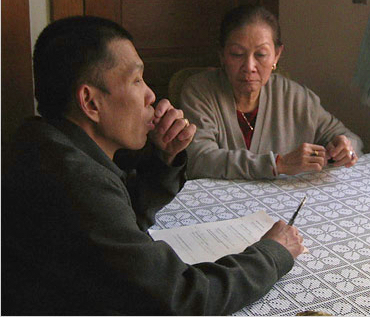“The Betrayal: Nerakhoon” (2008) began with Laotian refugee Thavisouk (“Thavi”) Phrasavath tutoring anthropologist Ellen Kuras in Lao during the mid-1980s. She videotaped him and his family some then and later shot some more interviews with him. He got involved in editing footage of an interview of his mother.
Kuras felt that the movie needed footage of Laos. Since the US government is still attempting to deny it fought a war in Laos (dropping more bombs there than the total tonnage the US dropped during two world wars), film shot from the Nixon era, when Thavi’s father worked with the US military remains classified.
In the 21st century Thavi was able to revisit his birthplace and track down the two sisters who were left behind. (They were at her mother’s when the human-smugglers came and said “We’re leaving now.” Thavi had swum across the Mekong earlier. His father was taken away for “re-education.) There is some poetic footage of rural Laos both in the movie and in a DVD bonus short, and footage of very emotional reunions of Thavi and his sisters (one was 18, one three when he left, and the younger one was adopted and take far north within Laos).
Thavi recalls someone in his hometown asking where he’s from and not believing “I was born and grew up here,” though, unfortunately, that was not filmed.
Most of the documentary (which was nominated for an Oscar) was shot in the US. The denial of the war in Laos continues to justify any benefits for the Laotians who were left behind when the US pulled out (any similarity to Hmong who fought with the Americans is completely not coincidental).
The wife of the Royal Laotian colonel/liaison to the USAF and the eight children who made it to Thailand were eventually granted asylum in the US, taken from the refugee camp in Thailand, and dumped in a crack house in Brooklyn. Not an easy adjustment in their second relocation, with physical safety much less than in the refugee camp.
As the eldest, Thavi had to try to father his younger siblings in an unfamiliar and dangerous environment. And Thavi resented having to father a brood he did not create, etc. There’s a very major surprise that I don’t want to reveal. It is perhaps surprising that there is only one funeral in the movie’s story, but it was filmed very revealingly, both for showing the cultural tradition and the family dynamics.

Though not obtrusive, I realize that the editing by Thavi is really, really good. He may not have known what a jump-cut is, but without any technical training, he brought out dramas in what Kuras shot. Howard Shore provided music with some gentle chanting and poignant string-playing that enhanced the images and very candid interview footage.
The betrayal of the title is the US government’s betrayal of the Laotian officers who worked with(/for) it, but there is at least one other major, heartbreaking one shown. (And, perhaps, Col. Phrasavath’s targeting US bombs onto the part of the Ho Chi Minh Trail in eastern Laos [there is no question that Laos’s neutrality was massively violated by North Vietnam troops and supplies moving along it]).
The disappointment in the liberators (American, then Pathet Lao), the anguish of trying to get by in Thailand and less-than-welcoming America is somewhat familiar to me from the poignant autobiographical novels by T. C. Huo, Thousand Wings and Land of Smiles; and the difficulty of holding a large Southeast Asian family together in an American slum from Andrew X. Pham’s luminous memoirs Catfish and Mandela and The Eaves of Heaven; Uyen Nicole Huong’s trilogy Daughters of the River Huong, Mimi and Her Mirror, and Postcards from Nam; GB Tran’s graphic novel Vietnamerica; and Andrew Lam’s memoir Perfume Dreams and collection of stories Birds of Paradise Lost. Perhaps such background, and other refugee stories such as “The Lost Boys of the Sudan,” made it easier for me to understand “Betrayal,” though what Thavi and his mother felt at various times over the 23 years of the movie’s gestation is probably clear enough. The DVD includes some newsreel footage on the US air war, a trailer, a stills gallery, and a commentary track.
©2010,2017 Stephen O. Murray
